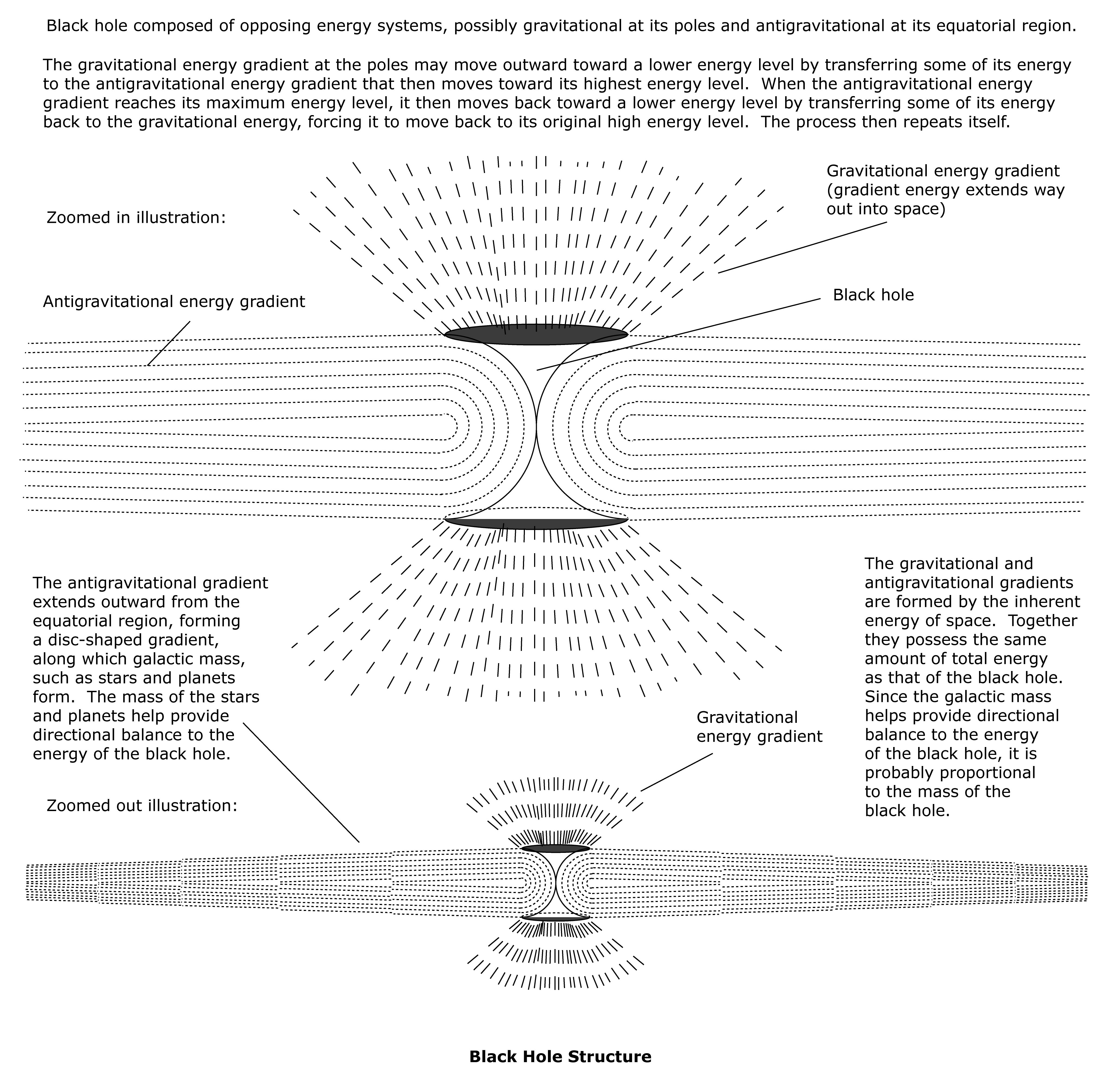
All fundamental energy is in constant motion. The inherent energy of space consists of basic units of 1-D bidirectional energy in random motion and distribution relative to each other. The basic units of 1-D energy compose the potential energy of space, while their rate of motion relative to each other constitutes the kinetic energy of space. The constant, random motion of the basic units of 1-D energy of space provides directional balance to the energy system, which composes all space. This energy is non-electromagnetic, and moves toward system directional balance. It is driven by two opposing forces: nonrandomness and randomness. The dynamic equilibrium of the energy of space is aimed at achieving perfect randomness, but the laws of probability allow nonrandomness to exist within the energy system. Electric, or unidirectional, energy, is one of the products of nonrandomness of the energy of space.
Electromagnetic energy, on the other hand, is driven by two opposing energies: electric energy composed predominantly of kinetic energy of space and magnetic energy composed primarily of potential energy of space. The two opposing forces exist perpendicular to each other to provide maximum opposing force and optimal directional balance.
Black Holes
The black hole at the center of our galaxy may possess a similar structure to e-m energy, with two directionally opposing and oscillating energies. However, its geometry may also contribute to the strength of its opposing forces. It may consist of opposing electric and magnetic energy. Or it may consist of opposing gravitational and inverted or anti-gravitational energy gradients. Or it may consist of opposing energies that we are not familiar with in our world.
In any case, the black hole nucleus of our universe may consist of two opposing energies. Let’s assume for the sake of illustration that one consists of gravitational energy gradient while the other consists of inverted or anti-gravitational energy gradient. So the gravitational energy gradient might exist at the poles of the black hole, while the inverted gravitational energy gradient might exist about the circumference of the black hole.
When the gravitational energy gradient moves toward a lower energy level, it transfers some of its energy to the inverted gravitational energy gradient, forcing it to move toward a higher energy level until it has reached its maximum energy level. Then the inverted gravitational energy gradient moves back toward a lower energy level by transferring some of its energy back to the gravitational energy gradient, forcing it to return to its original high energy level. This process repeats itself in a never-ending cycle (similar to electromagnetic interactions). The black hole essentially acts as an extremely high energy pump.
(Note: If the opposing energies of a black hole are gravitational, then they consist within a region of space that is much different than that elsewhere in the galaxy and interstellar space – in order to produce such strong gravitational gradients. Keep in mind that in our world, gravitational gradients are limited due to the ability of the energy of space to create a changing ratio of potential to kinetic energy of space inward toward a body of mass (or 2-D or 3-D e-m particle), and this ability is finite. For instance, at absolute zero, the inherent energy of space may consist of all or almost all potential energy, so that it may not be able to produce a gravitational gradient.)
For a black hole serving as the nucleus of a galaxy, the galactic mass consisting of stars, planets, and the energy of interstellar space may also provide directional balance to the inverted gravitational energy gradient, so that the gravitational energy gradient of the black hole does not have to provide all the directional balance required of the inverted gravitational energy gradient. If this is true, then the inverted gravitational energy gradient of the black hole may be extremely energetic and transfer some of this energy to the gravitational energy gradient of the black hole as they trade places moving from high to low energy levels. This also means that the total mass in a galaxy is most likely proportional to the size of the black hole at its center. The entire galaxy, then, may also act as a giant pump, oscillating with the interactions of the black hole.

Sister Universes
Universes might exist in pairs, with one universe moving outward toward a lower energy level, forcing its “sister” universe to move inward toward a higher energy level (ending in a big bang). The sister universes may be adjacent to other sister universes, so that there is an endless network of sister universes oscillating between high and low energy levels. In such a model, adjacent universes may influence the behavior of a universe and even “sister” universes so that making predictions would require considering a variety of complex variables (e.g., variables within a single universe, within the pair of universes, and within the wider network of universes).
The “sister” universes would be perpendicular to each other to provide maximum opposing force, and therefore optimal directional balance. As one sister universe is experiencing a “big bang,” its partner universe has just reached its lowest possible energy level (outward), and is beginning its journey back toward its highest energy level at system center where it will then experience a “big bang.” The two perpendicular sister universes move in and out alternating between high and low energy levels in a similar manner to electric and magnetic energy in an electromagnetic interaction.
So it should be possible to observe the sister universe from its partner universe. If the sister universe is moving outward (with negative acceleration) toward a lower energy level while its partner universe is moving inward (with positive acceleration) toward a higher energy level, the observer in the latter universe will “see” the matter in the outer regions of observable space accelerating outward. However, what the observer is actually witnessing it the two sister universes moving away from each other. But would there ever be a point in the oscillation of the two perpendicular universes where it appears that one is accelerating away from the other, or would the negative and positive accelerations of the respective sister universes “cancel” out and appear to an observer in one of the universes to possess constant velocity?
